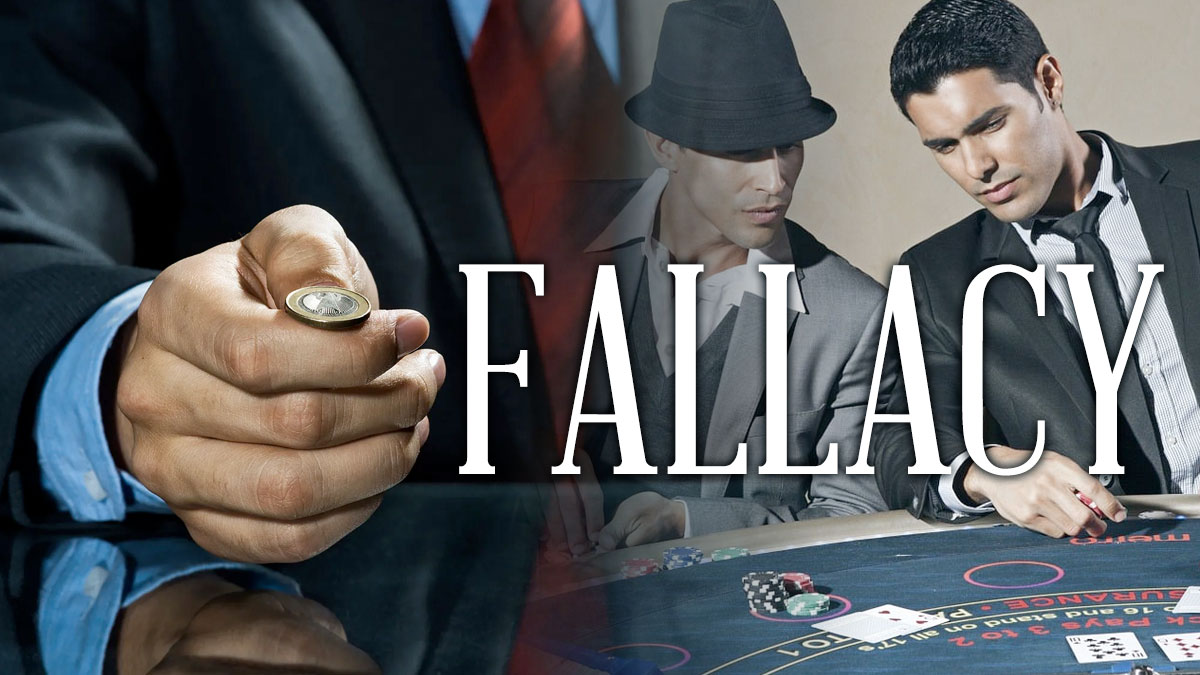The Gambler’s Fallacy is the iceberg that has sunk so many bankrolls. It lays in wait just out of sight for the unsuspecting or novice gambler.
Then BOOM!
Down goes another poor misguided soul.
What is The Gambler’s Fallacy?
It’ the misconception that simply because something has not occurred for an extended period it has become overdue.
Imagine flipping a coin and coming up tails 20 straight times. The Gambler’s Fallacy would have people believing the next flip must come up heads.
This is dangerous thinking if you’re a gambler.
Monte Carlo Fallout
On one sensational evening in August, 1913 at the Le Grande Casino magic happened. An event that coined the term “The Monte Carlo Fallacy.”
As gamblers huddled around the roulette wheel, the ball landed on black.
That’s nothing special.
But on this night, it landed on black repeatedly.
Not for 10 consecutive spins. Not even for 20 spins of the wheel.
No, that little white ball landed on a black number 29 spins in succession.
To put this into context, the likelihood of that happening is about 1 in 67 million.
You are 67 times more likely to be struck by lightning in any given year.
What makes this incident so iconic is the insane amount of cash that was dropped during the streak. Once the wheel landed on black for the tenth consecutive spin, casino goers started placing bigger and bigger bets on red.
They had fallen victim to the Gambler’s Fallacy, thinking surely each subsequent spin would surely be red.
Unfortunately, the wheel doesn’t remember what the previous results were. Every single spin is independent of all others. The chances of black hitting remained at 18 out of 37 just like always.
This run had the owners of Le Grande over 10 million francs richer. Many casino patrons were left with an unbelievable story and little else.
So, You’re Saying There’s A Chance
I want to make one thing clear; probability is not the same as chance.
Consider the following:
Wagering on the flip of a coin is perhaps the most basic form of gambling. So, let’s use that as our example.
Obviously, the chance of heads or tails is equal at 50%. This is an absolute and is as true after 10,000 coin flips as it was on number 1. It makes no difference if tails just came up 9,999 times.
Odds are the chance of one result against the chance of another. Heads and tails both have a single chance.
Probability changes over time. For example, on your first coin flip, the chances of heads is 1/2 as is probability.
However, as more chances occur, they multiply to shape probability. The probability of getting 3 consecutive heads is 1/8 and for 5 in a row is 1/32. Yet, the chances remain 1/2 for each flip.
It’s easy to see why any savvy gambler, after seeing 4 straight heads, would recognize the probability of a 5th at 1/32 and go all-in on tails.
This is the Gambler’s Fallacy at its best.
Sure, it’s not likely you’ll see heads again, but there’s still a 50/50 chance.
Super Size Your Scope
I see so many gamblers tend to only think in these small-scale numbers. They don’t intentionally think so small. I believe we are conditioned that way.
What they fail to recognize is that it’s only when the numbers begin to multiply that the odds start to become clear.
To illustrate this, I conducted a little experiment here in my office. I just took a quarter from my desk drawer and flipped it 10 times. I won’t bore you with the play by play. The results were 6 for heads and 4 for tails.
Some may look at this and think that means clearly heads are a favorite at 60/40. I assure you if I extended the groundbreaking research I’m conducting to 100 or even 1000 tosses, the results would be even closer.
Let’s assume that I started my experiment over and this time made 100 coin flips. There’s absolutely nothing that would stop the first 50 being tails and the last 50 coming up heads.
The most glaring flaw in this reasoning that propagates the Gambler’s Fallacy is random distribution.
Fallacy Exposed
Back to that unfortunate gambler that was certain the next flip of the coin can’t possibly complete the run of 5 consecutive heads and bets it all on tails.
They don’t understand that the probability was only true before the first coin toss. After the fourth heads come up, any previous results essentially become a whole outcome.
This effectively resets the counter to 1/2 again — just as it will do on each individual coin toss into infinity.
The fallacy here is the misguided thinking that the next toss will more likely be a tail because of past results. Or that a previous run of good fortune may somehow alter the odds of present or future results.
Can’t Stand the Heat
If you are familiar with basketball, you’re likely familiar with the “hot hand” theory. This follows the logic that a player who has made a run of shots can’t miss and is therefore likely to make the next shot.
Most people tend to predict any particular outcome based largely on the most recent sample. If Tiger Woods drains an 18ft putt on hole 15, he can’t miss the 16 footer on 17. But he can.
It may not be likely, because he’s Tiger Woods, but he can.
In fact, there’s evidence that the victims of the gambler’s fallacy, that something which has continued to happen won’t reoccur, are equally susceptible to this hot hand fallacy.
The simple idea that both could coexist is ridiculous.
Clearly, they can’t both be correct.
Both are completely bogus.
Day Trader’s Fallacy?
This fallacious reasoning can also be seen in the stock market. They have been the driving force behind countless poor investment strategies and sent more than one unlucky investor on the hunt for a bankruptcy attorney.
There have been many fortunes lost trying to predict when market trends may shift or follow the hot investment broker that just can’t lose.
Either one can have disastrous results. What they fail to account for is possible acceleration in declines.
Hunter S. Thompson once quipped,
“History is hard to know-”
and he was right.
However, depending on the game, gamblers can never be 100% sure whether the chances are truly being dictated by mathematics. There are those that would choose to employ, ahem, enhanced tactics.
Cheating has been around for as long as the games have been played. People have weighted dice and even rigged roulette wheels to gain an edge.
Obviously, in these instances, all odds or probabilities go out the window. You better go with the hot hand if you learn of a player with such an advantage.
On second thought, you’ll probably be better off just walking away.
In Case You Missed Something
If you skipped straight to the end, I don’t want you to go home empty-handed. For the rest of you, here’s some important food for thought.
If you have looked into betting systems, you probably noticed the popularity of negative progression styles of wagering. These encourage you to increase the size of your wager after a loss.
The Martingale is king of the mountain here. In this system, you place even-money wagers at the roulette table and double your bet after every loss. The logic here is that eventually a win will cancel out any previous losses and leave a small profit.
However, negative progression systems ultimately implode. You have a 0% guarantee that you’ll finally take a win before the money gets too big. You’re either going to run out of cash or hit the table limit at some point.
I made my first trip to a casino as a college student. I had a teammate on the baseball team convince me that he could easily show me how to double or triple the $300 my parents had sent me for my birthday.
On the 3 ½ hour drive to the nearest casino, he laid out his foolproof plan, later to be identified as the Martingale System.
It was not a fun trip.
Less than 2 hours after our arrival, I sat in the parking garage sick at the thought of what had just occurred.
I wouldn’t step back into a casino for several years.
The stakes got too high and I lost it all.
Conclusion
So, let’s see if you have learned anything.
Assume you’re at the roulette table, and black just came up 15 times in a row.
Should you place your chips on black or red for the 16th spin?
You’re absolutely correct.
It doesn’t matter one bit.
They are both 50/50. The result of the next spin has no interest in any previous results. Many gamblers may fall prey to this fact, but not you.
The casinos are all too happy to assist the delusional thinking. They go so far as giving pieces of paper to players that wish to keep tally of the previous results.
Why else would the casino put a marquee on the roulette table showing the results of the past several spins?
They know the Gambler’s Fallacy helps keep the lights on.
Just remember that every bet you make is on an independent event. The probability of that event isn’t affected by what happened on previous events.
Michael Stevens
Michael Stevens has been researching and writing topics involving the gambling industry for well over a decade now and is considered an expert on all things casino and sports betting. Michael has been writing for GamblingSites.org since early 2016. …



